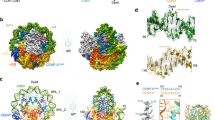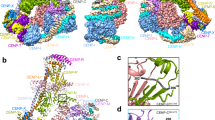Abstract
This protocol describes a cell-free system for studying vertebrate centromere and kinetochore formation. We reconstitute tandem arrays of centromere protein A (CENP-A) nucleosomes as a substrate for centromere and kinetochore assembly. These chromatin substrates are immobilized on magnetic beads and then incubated in Xenopus egg extracts that provide a source for centromere and kinetochore proteins and that can be cycled between mitotic and interphase cell cycle states. This cell-free system lends itself to use in protein immunodepletion, complementation and drug inhibition as a tool to perturb centromere and kinetochore assembly, cytoskeletal dynamics, DNA modification and protein post-translational modification. This system provides a distinct advantage over cell-based investigations in which perturbing centromere and kinetochore function often results in lethality. After incubation in egg extract, reconstituted CENP-A chromatin specifically assembles centromere and kinetochore proteins, which locally stabilize microtubules and, on microtubule depolymerization with nocodazole, activate the mitotic checkpoint. A typical experiment takes 3 d.
This is a preview of subscription content, access via your institution
Access options
Subscribe to this journal
Receive 12 print issues and online access
$259.00 per year
only $21.58 per issue
Buy this article
- Purchase on Springer Link
- Instant access to full article PDF
Prices may be subject to local taxes which are calculated during checkout







Similar content being viewed by others
References
Cheeseman, I.M. & Desai, A. Molecular architecture of the kinetochore-microtubule interface. Nat. Rev. Mol. Cell Biol. 9, 33–46 (2008).
Guse, A., Carroll, C.W., Moree, B., Fuller, C.J. & Straight, A.F. In vitro centromere and kinetochore assembly on defined chromatin templates. Nature 477, 354–358 (2011).
Huynh, V., Robinson, P. & Rhodes, D. A method for the in vitro reconstitution of a defined. J. Mol. Biol. 345, 957–968 (2005).
Luger, K., Rechsteiner, T.J., Flaus, A.J., Waye, M.M. & Richmond, T.J. Characterization of nucleosome core particles containing histone proteins made in bacteria. J. Mol. Biol. 272, 301–311 (1997).
Desai, A., Deacon, H.W., Walczak, C.E. & Mitchison, T.J. A method that allows the assembly of kinetochore components onto chromosomes condensed in clarified Xenopus egg extracts. Proc. Natl. Acad. Sci. USA 94, 12378–12383 (1997).
Heald, R. et al. Self-organization of microtubules into bipolar spindles around artificial chromosomes in Xenopus egg extracts. Nature 382, 420–425 (1996).
Maresca, T.J. & Heald, R. Methods for studying spindle assembly and chromosome condensation in Xenopus egg extracts. Methods Mol. Biol. 322, 459–474 (2006).
Murray, A.W. & Kirschner, M.W. Cyclin synthesis drives the early embryonic cell cycle. Nature 339, 275–280 (1989).
Desai, A., Murray, A., Mitchison, T.J. & Walczak, C.E. The use of Xenopus egg extracts to study mitotic spindle assembly and function in vitro. Methods Cell Biol. 61, 385–412 (1999).
Hannak, E. & Heald, R. Investigating mitotic spindle assembly and function in vitro using Xenopus laevis egg extracts. Nat. Protoc. 1, 2305–2314 (2006).
Carroll, C.W., Milks, K.J. & Straight, A.F. Dual recognition of CENP-A nucleosomes is required for centromere assembly. J. Cell Biol. 189, 1143–1155 (2010).
Carroll, C.W., Silva, M.C., Godek, K.M., Jansen, L.E. & Straight, A.F. Centromere assembly requires the direct recognition of CENP-A nucleosomes by CENP-N. Nat. Cell Biol. 11, 896–902 (2009).
Lowary, P. & Widom, J. New DNA sequence rules for high affinity binding to histone octamer and sequence-directed nucleosome positioning. J. Mol. Biol. 276, 19–42 (1998).
Luger, K., Rechsteiner, T. & Richmond, T. Preparation of nucleosome core particle from recombinant histones. Methods Enzymol. 304, 3–19 (1999).
Minshull, J., Sun, H., Tonks, N.K. & Murray, A.W. A MAP kinase-dependent spindle assembly checkpoint in Xenopus egg extracts. Cell 79, 475–486 (1994).
Kim, S., Song, E., Lee, K. & Ferrell, J. Jr. Multisite M-phase phosphorylation of Xenopus Wee1A. Mol. Cell Biol. 25, 10580–10590 (2005).
Blow, J.J. & Laskey, R.A. Initiation of DNA replication in nuclei and purified DNA by a cell-free extract of Xenopus eggs. Cell 47, 577–587 (1986).
Harrington, J.J., Van Bokkelen, G., Mays, R.W., Gustashaw, K. & Willard, H.F. Formation of de novo centromeres and construction of first-generation human artificial microchromosomes. Nat. Genet. 15, 345–355 (1997).
Ikeno, M. et al. Construction of YAC-based mammalian artificial chromosomes. Nat. Biotechnol. 16, 431–439 (1998).
Nakashima, H. et al. Assembly of additional heterochromatin distinct from centromere-kinetochore chromatin is required for de novo formation of human artificial chromosome. J. Cell Sci. 118, 5885–5898 (2005).
Okada, T. et al. CENP-B controls centromere formation depending on the chromatin context. Cell 131, 1287–1300 (2007).
Nakano, M. et al. Inactivation of a human kinetochore by specific targeting of chromatin modifiers. Dev. Cell. 14, 507–522 (2008).
Ohzeki, J. et al. Breaking the HAC Barrier: Histone H3K9 acetyl/methyl balance regulates CENP-A assembly. EMBO J. 31, 2391–2402 (2012).
Barnhart, M.C. et al. HJURP is a CENP-A chromatin assembly factor sufficient to form a functional de novo kinetochore. J. Cell Biol. 194, 229–243 (2011).
Gascoigne, K.E. et al. Induced ectopic kinetochore assembly bypasses the requirement for CENP-A nucleosomes. Cell 145, 410–422 (2011).
Mendiburo, M.J., Padeken, J., Fulop, S., Schepers, A. & Heun, P. Drosophila CENH3 is sufficient for centromere formation. Science 334, 686–690 (2011).
Hyman, A.A., Middleton, K., Centola, M., Mitchison, T.J. & Carbon, J. Microtubule-motor activity of a yeast centromere-binding protein complex. Nature 359, 533–536 (1992).
Kingsbury, J. & Koshland, D. Centromere-dependent binding of yeast minichromosomes to microtubules in vitro. Cell 66, 483–495 (1991).
Sandall, S. et al. A Bir1-Sli15 complex connects centromeres to microtubules and is required to sense kinetochore tension. Cell 127, 1179–1191 (2006).
Sorger, P.K., Severin, F.F. & Hyman, A.A. Factors required for the binding of reassembled yeast kinetochores to microtubules in vitro. J. Cell Biol. 127, 995–1008 (1994).
Akiyoshi, B., Nelson, C.R., Ranish, J.A. & Biggins, S. Quantitative proteomic analysis of purified yeast kinetochores identifies a PP1 regulatory subunit. Genes Dev. 23, 2887–2899 (2009).
Akiyoshi, B. et al. Tension directly stabilizes reconstituted kinetochore-microtubule attachments. Nature 468, 576–579 (2010).
Luger, K., Rechsteiner, T.J. & Richmond, T.J. Expression and purification of recombinant histones and nucleosome reconstitution. Methods Mol. Biol. 119, 1–16 (1999).
Vary, J.C. Jr, Fazzio, T.G. & Tsukiyama, T. Assembly of yeast chromatin using ISWI complexes. Methods Enzymol. 375, 88–102 (2004).
Selleck, W. & Tan, S. Recombinant protein complex expression in E. coli. Curr. Protoc. Protein Sci. 52, 5.21.1–5.21.21 (2008).
Tan, S. A modular polycistronic expression system for overexpressing protein complexes in Escherichia coli. Protein Expr. Purif. 21, 224–234 (2001).
Black, B.E. et al. Structural determinants for generating centromeric chromatin. Nature 430, 578–582 (2004).
Thastrom, A. et al. Sequence motifs and free energies of selected natural and non-natural nucleosome positioning DNA sequences. J. Mol. Biol. 288, 213–229 (1999).
Acknowledgements
The phospho-Wee1 antibody was a gift from J.E. Ferrell (Stanford University School of Medicine). The histone expression plasmids were a gift from K. Luger (Colorado State University). The pST39 plasmid was a gift from S. Tan (Pennsylvania State University). The 19 × 601 plasmid was a gift from D. Rhodes (Medical Research Council Laboratory of Molecular Biology). A.G. was supported by a postdoctoral fellowship from the German Research Foundation (DFG), C.J.F. by a Stanford Lieberman Fellowship, and this work was supported by US National Institutes of Health grant no. R01GM074728 to A.F.S.
Author information
Authors and Affiliations
Contributions
A.G., C.J.F. and A.F.S. wrote the manuscript.
Corresponding author
Ethics declarations
Competing interests
The authors declare no competing financial interests.
Supplementary information
Supplementary Methods
beadMeasurements3.m. MATLAB script for quantifying fluorescence associated with beads in three channels, which implements the analysis described in Box 3. (Documentation on using the script is contained in the comments in the script file.) (ZIP 3 kb)
Rights and permissions
About this article
Cite this article
Guse, A., Fuller, C. & Straight, A. A cell-free system for functional centromere and kinetochore assembly. Nat Protoc 7, 1847–1869 (2012). https://doi.org/10.1038/nprot.2012.112
Published:
Issue Date:
DOI: https://doi.org/10.1038/nprot.2012.112
This article is cited by
-
Differential nuclear import sets the timing of protein access to the embryonic genome
Nature Communications (2022)
-
Insights from biochemical reconstitution into the architecture of human kinetochores
Nature (2016)
-
Comparative analysis of linker histone H1, MeCP2, and HMGD1 on nucleosome stability and target site accessibility
Scientific Reports (2016)
-
Acetylation of histone H4 lysine 5 and 12 is required for CENP-A deposition into centromeres
Nature Communications (2016)
Comments
By submitting a comment you agree to abide by our Terms and Community Guidelines. If you find something abusive or that does not comply with our terms or guidelines please flag it as inappropriate.



